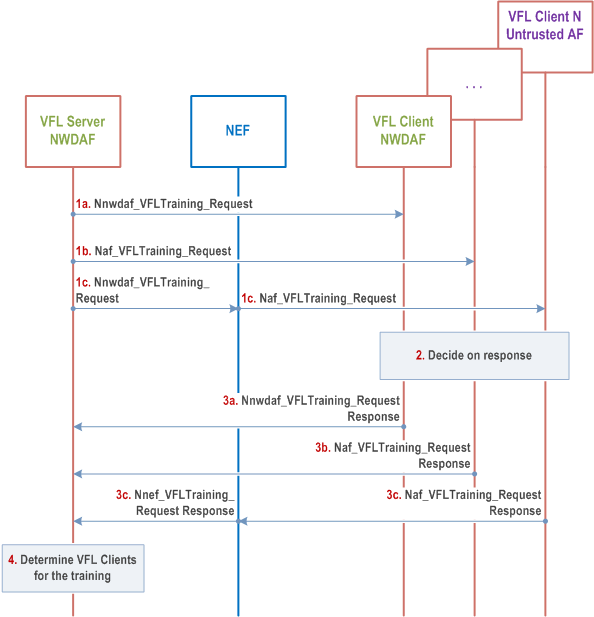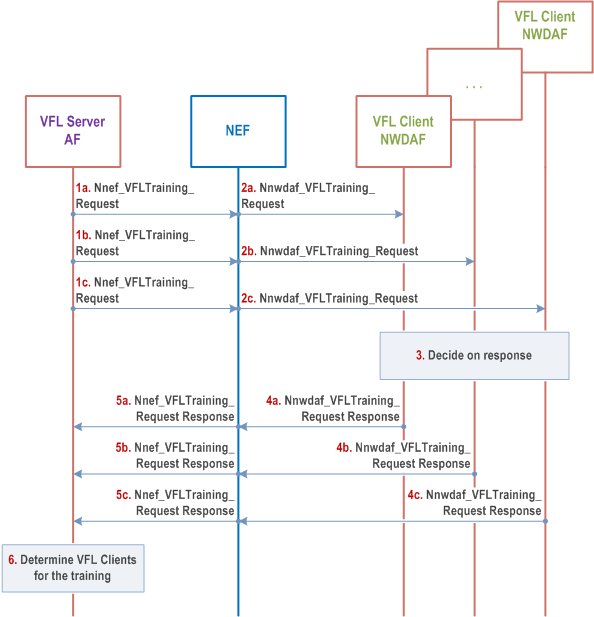Content for TS 23.288 Word version: 19.1.0
1…
4…
5…
5A…
6…
6.1.3
6.1.4…
6.1.4.4…
6.1.5…
6.1A…
6.1B…
6.1B.2.3…
6.1C
6.2…
6.2.3…
6.2.6…
6.2.6.2
6.2.6.3…
6.2.6.3.3
6.2.6.3.4
6.2.6.3.5
6.2.6.3.6…
6.2.7…
6.2.8…
6.2.9…
6.2.13…
6.2A…
6.2B…
6.2B.3
6.2B.4…
6.2C…
6.2D…
6.2E…
6.2F…
6.2H…
6.2H.2.2…
6.2H.2.3…
6.2H.2.4…
6.3…
6.4…
6.5…
6.6…
6.7…
6.7.3…
6.7.4…
6.7.5…
6.8…
6.9…
6.10…
6.11…
6.12…
6.13…
6.14…
6.16…
6.17…
6.18…
6.19…
6.20…
6.21…
6.22…
6.23…
7…
7.4…
7.7…
7.9…
8…
9…
10…
6.2H.2.2 Preparation procedure for Vertical Federated Learning
6.2H.2.2.0 General
6.2H.2.2.1 Preparation procedure for Vertical Federated Learning when NWDAF is the VFL Server
6.2H.2.2.2 Preparation procedure for Vertical Federated Learning when untrusted AF is the VFL server
...
...
6.2H.2.2 Preparation procedure for Vertical Federated Learning p. 165
6.2H.2.2.0 General p. 165
The preparation procedure is used to check if the VFL Client(s) can meet the ML Model training requirement. The procedure includes the negotiation, between server and client(s) to enable interoperability, sample alignment and may include feature negotiation if the VFL Server did not learn the supported FeatureIDs from each VFL Client using the discovery phase, alternatively the VFL Server may know the supported FeatureIDs by a VFL Client based on configuration. The Vertical Federated Learning preparation procedure can be skipped if the VFL Server can decide which VFL Client(s) support the VFL procedure to be performed, e.g. based on local configuration or offline procedures.
6.2H.2.2.1 Preparation procedure for Vertical Federated Learning when NWDAF is the VFL Server p. 166

Step 1.
The NWDAF as VFL Server may send a Vertical Federated Learning preparation request including the Analytics ID to each of the NWDAF VFL Client(s), using Nnwdaf_VFLTraining_Request and to each of the AF VFL Clients(s), using Naf_VFLTraining_Request possibly via NEF when the VFL Client is an untrusted AF. The NWDAF as a VFL Server also provides, the suggested VFL Interoperability Information to negotiate the intermediate resuls that will be used in training, the suggested list of sample IDs that will be used in training.
Step 2.
Each VFL Client checks if it can meet the ML Model training requirement. Each VFL Client ID checks the list of sample IDs suggested by the VFL Server and then provides to the VFL Server the list of sample IDs that it can accept out of the sample IDs suggested by the VFL Server. Each VFL Client checks the VFL Interoperability Information and determines which VFL Interoperability information that the VFL Client accepts. The VFL Clients provides the list of supported Feature IDs to the VFL Server, if available, alternatively the VFL clients may not want to reveal Feature IDs or VFL Server may know the supported FeatureIDs for a VFL Client based on configuration.
Step 3.
Each NWDAF VFL Client invokes Nnwdaf_VFLTraining_Response or and each AF VFL Client invokes Naf_VFLTrainingRequest_Response , possibly via NEF when the AF is untrusted, to indicate to the VFL Server whether it accepts the ML Model training requirements, the VFL Client can also indicate that it cannot join the FL process.
Step 4.
The VFL server determines the final list of samples considering the samples that all selected VFL clients support, if used the Feature ID per VFL client and VFL Interoperability Information to be used for training and provide them to the selected VFL Clients at the start of the training phase, as described in clause 6.2H.2.3.1.
6.2H.2.2.2 Preparation procedure for Vertical Federated Learning when untrusted AF is the VFL server p. 167
This clause specifies the preparation (including sample alignment) procedure for untrusted AF-initiated VFL scenarios between AF and NWDAF(s) within a single PLMN.

Step 1.
The untrusted AF as VFL server sends VFL preparation requests to each of the candidate VFL client(s), using Nnef_VFLTrainingRequest_Request to check if the VFL client(s) can meet the ML Model training requirement (which includes the Analytics ID, list of sample IDs, and optionally Feature ID, etc.). The external NWDAF IDs obtained in the discovery procedure (see clause 6.2H.2.1.1) is included to indicate the target NWDAFs. The suggested VFL Interoperability Information to negotiate the intermediate resuls that will be used in training.
Step 2.
The NEF maps the external NWDAF and GPSI(s) to the internal NWDAF and SUPI(s). The NEF send VFL preparation request to the candidate internal NWDAF ID using Nnwdaf_VFLTraining_Request service with the same information as provided in step 1 in clause 6.2H.2.2.1.
Step 3.
Same as step 2 in clause 6.2H.2.2-1.
Step 4.
Same as step 3 in clause 6.2H.2.2-1.
Step 5.
The NEF maps the internal NWDAF and SUPI(s) to the external NWDAF and GPSI(s). The NEF sends the Nnef_VFLTraining_Request Response to the VFL Server with the same information as provided in step 4.
Step 6.
Same as step 4 in clause 6.2H.2.2-1.